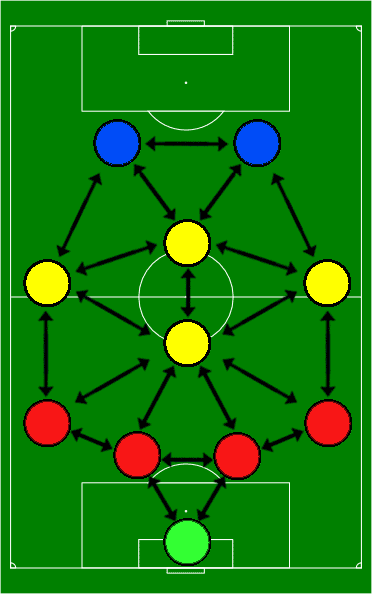Soccer Triangle for Kids...Not Likely
Anyone watching a children’s soccer game sees the same thing: a herd of overanxious kids chasing the ball around the field. It’s ugly, I know.
Generally, at any stage under the age of 8, the goal for children will be to develop some fundamental skills, get some exercise and most importantly, have fun.
Once they get older though, it’s another story.
Soccer Triangle Basics
One of the first things any youth soccer coach will teach his players is the importance of staying in position.

Spreading out on the field allows a team to use the space more effectively and let the ball do the work. Good team passing will allow a squad to maintain possession longer and create plays.
That’s all well and good, but how does a team ensure that there is always someone available to take a pass? Well that’s where the soccer triangle comes into play.
Not just a pretty geometric pattern, the diagram on the right shows a typical 4-4-2 formation with all of the possible triangles created if each player remains in position.
As you can see, remaining in position is absolutely integral to ensuring the player with the ball has a passing lane to the open player.
Because there are so many possible triangles that can be created, there is always going to be a lane forward. If not, move the ball backwards, reset, and take a different look. The triangle means that you should always have possession.
Checking In and Out
Obviously, the goal of the triangle is to maintain possession. But we also want to move the play forward. You may hear during the course of a match a player being told to “check to the ball” or “check out of the play”.
Checking to the ball means moving into the passing lane and making a move towards the ball. In this way, you present a clear passing option for the player with the ball.
Remember, never run away from a pass! Always ensure you move to the ball as it’s played to you, otherwise alert defenders will beat you to it and gain possession. In fact, many defenders will play possum by remaining goal side in anticipation of the pass coming only to jump out in front and win the ball.
Checking out of the play means moving away from the ball carrier in an attempt to draw your marker away and create space for the player with the ball. If you’re not in a position to receive the ball and you won’t be able to get to one, trying checking out of the play instead to create space. Staying still will only clutter the field and make it harder for the play to move forward.











